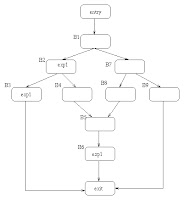* Global constant and copy propagation.
* Global common subexpression elimination.
EGCS has two implementations of global common subexpression elimination. The first is based on the classic algorithm found in most compiler texts and is generally referred to as GCSE or classic GCSE.
The second implementation is commonly known as partial redundancy elimination (PRE). PRE is a more powerful scheme for eliminating redundant computations throughout a function. Our PRE optimizer is currently based on Fred Chow's thesis.
The difference between GCSE and PRE is best illustrated with an example flow graph (please forgive the poor graphics, I'm no HTML or graphics guru).

This example has a computation of "exp1" in blocks B2, B3 and B6. Assume that the remaining blocks do not effect the evaluation of "exp1".
Classic GCSE will only eliminate the computation of "exp1" found in block B3 since the evaluation in block B6 can be reached via a path which does not have an earlier computation of "exp1" (entry, B1, B7, B8, B5, B6).
PRE will eliminate the evaluations of "exp1" in blocks B3 and B6; to make the evaluation in B6 redundant, PRE will insert an evaluation of "exp1" in block B8.
While PRE is a more powerful optimization, it will tend to increase code size to improve runtime performance. Therefore, then optimizing for code size, the compiler will run the classic GCSE optimizer instead of the PRE optimizer.
Global constant/copy propagation and global common subexpression elimination are enabled by default with the -O2 optimization flag. They can also be enabled with the -fgcse flag.
No comments:
Post a Comment